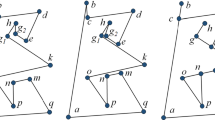Abstract
The reconstruction of an object from a single 2D projection of a 3D wireframe model is a vision problem with applications in CAD/CAM and computer graphics.We propose an algorithm for the interpretation of wireframe projections based on assigning semantic and numerical depth labels to lines. This method allows us to state necessary and sufficient conditions for the physical realisability of a wireframe projection of a curved object. The presence of linear features provides further constraints on the positions of object vertices. For example, each straight line gives rise to a coplanarity constraint between a set of object vertices.
We show that extra information, such as vanishing points, parallel lines or user-entered depth-parity information, is sufficient to uniquely determine the face-circuits in wireframe projections of polyhedra with simple trihedral vertices. In fact, a polyhedron with simple trihedral vertices can be unambiguously reconstructed from its 3D wireframe model.
Similar content being viewed by others
References
Agarwal, S.C. and Waggenspack, W.N. Jr. 1992. Decomposition method for extracting face topologies from wireframe models. Computer-Aided Design, 24(3):123–140.
Alevizos, P.D. 1991. A linear algorithm for labeling planar projections of polyhedra. In Proc. IEEE/RSJ International Workshop on Intelligent Robots and Systems IROS’91, pp. 595–601.
Clowes, M.B. 1971. On seeing things. Artificial Intelligence, 2:79–116.
Cooper, M.C. 1993. Interpretation of line drawings of complex objects. Image and Vision Computing, 11(2):82–90.
Cooper, M.C. 1997. Interpreting line drawings of curved objects with tangential edges and surfaces. Image and Vision Computing, 15:263–276.
Cooper, M.C. 1999. Linear-time algorithms for testing the realisability of line drawings of curved objects. Artificial Intelligence, 108:31–67.
Cooper, M.C. 2000. Linear constraints for the interpretation of line drawings of curved objects. Artificial Intelligence, 119:235–258.
Cooper, M.C. 2001. The interpretation of line drawings with contrast failure and shadows. International Journal of Computer Vision, 43(2):75–97.
Ernst, B. 1986. Adventures with Impossible Figures. Tarquin Publications.
Huffman, D.A. 1971. Impossible objects as nonsense sentences. In Machine Intelligence, Melltzer, B. and Michie, D. (Eds.). Edinburgh University Press, Vol. 6, pp. 295–323.
Jain, P.K. 1999. Extraction of compound volumetric fatures from a three-dimensional wire frame model. Procs of the Institute of Mechanical Engineers Part B Journal of Engineering Manufacture, 213(6):597–613.
Kirousis, L.M. and Papadimitriou, C.H. 1988. The complexity of recognizing polyhedral scenes. J. Comput. System Sci, 37(1):14–38.
Kuo, M.H. 1998. A Systematic Approach Towards Reconstructing 3D Curved Models from Multiple 2D Views. In Graphics Recognition: Algorithms and systems; 2nd International Workshop, GREC’97, K. Tombre and A.K. Chhabra (Eds.), LNCS 1389, Springer, pp. 265–279.
Leclerc, Y.G. and Fischler, M.A. 1992. An optimization-based approach to the interpretation of single line drawings as 3D wire frames. International Journal of Computer Vision, 9(2):113–136.
Lipson, H. and Shpitalni, M. 1996. Optimisation-based reconstruction of a 3D object from a single freehand line drawing. Computer-Aided Design, 28(8):651–663.
Malik, J. 1987. Interpreting line drawings of curved objects. International Journal of Computer Vision, 1:73–103.
Marill, T. 1991. Emulating the human interpretation of line- drawings as three-dimensional objects. International Journal of Computer Vision, 6(2):147–161.
Markowsky, G. and Wesley, M.A. 1980. Fleshing out wire frames. IBM Journal of Research and Development, 24(5):582–597.
Mortenson, M. 1997. Geometric Modelling. 2nd edn J. Wiley.
Parodi, P. and Torre, V. 1994. On the complexity of labeling perspective projections of polyhedral scenes. Artificial Intelligence, 70:239–276.
Penrose, L.S and Penrose, R. 1958. Impossible objects, a special kind of visual illusion. British Journal of Psychology.
Ros, L. and Thomas, F. 2002. Overcoming superstrictness in line drawing interpretation. IEEE Trans. Pattern Analysis and Machine Intelligence, 24(2).
Shpitalni, M. and Lipson, H. 1996. Identification of faces in a 2D line drawing projection of a wireframe object. IEEE Trans. on Pattern Analysis and Machine Intelligence, 18(10):1000–1012.
Sugihara, K. 1978. Picture language for skeletal polyhedra. Computer Graphics Image Processing, 8:382–405.
Sugihara, K. 1986. Machine Interpretation of Line Drawings. MIT Press: Cambridge, MA.
Syeda-Mahmood, T. 1999. Indexing of technical line drawing databases. IEEE Trans. on Pattern Analysis and Machine Intelligence, 21(8):737–751.
Varley, P.A.C. and Martin, R.R. 2001. The junction catalogue for labelling line drawings of polyhedra with tetrahedral vertices. International Journal of Shape Modelling, 7(1):23–44.
Vosniakos, G. 1997. Conversion of wireframe to ACIS solid models for 21/2-D engineering components. The International Journal of Advanced Manufacturing Technology, 14(3):199–209.
Vosniakos, G. 1998. An intelligent software system for the automatic generation of NC programs from wireframe models of 2-1/2 D mechanical parts. Computer Integrated Manufacturing Systems, 11(1/2):53–65.
Wesley, M.A. and Markowsky, G. 1981. Fleshing out projections. IBM Journal of Research and Development, 25(6):934–954.
Author information
Authors and Affiliations
Corresponding author
Rights and permissions
About this article
Cite this article
Cooper, M.C. Wireframe Projections: Physical Realisability of Curved Objects and Unambiguous Reconstruction of Simple Polyhedra. Int J Comput Vision 64, 69–88 (2005). https://doi.org/10.1007/s11263-005-1087-9
Received:
Revised:
Accepted:
Published:
Issue Date:
DOI: https://doi.org/10.1007/s11263-005-1087-9




